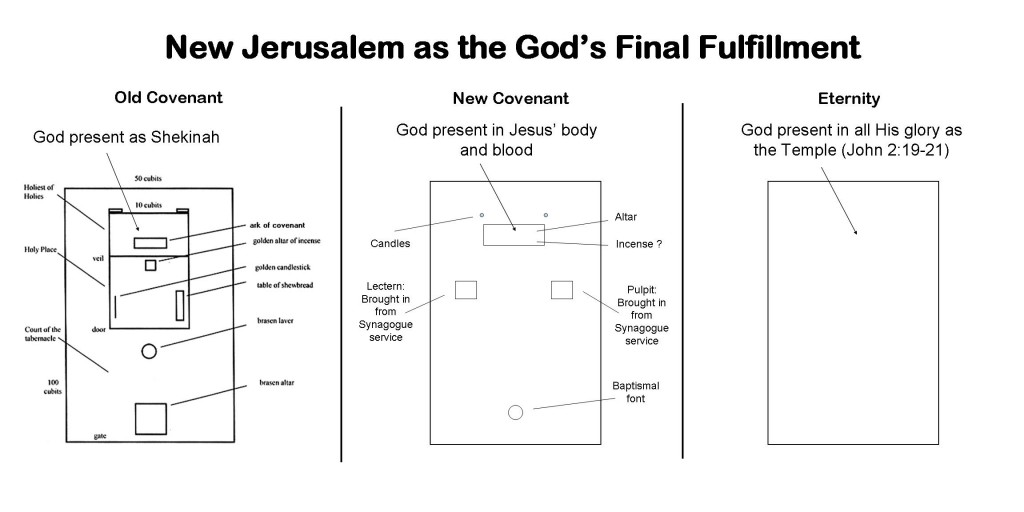 In Chapter 20, John briefly described the end of the old creation: “Then I saw a great white throne and him who was seated on it. From his presence earth and sky fled away, and no place was found for them” (20:11). We also find John being brief here, as he describes the new creation and the new Jerusalem.
In Chapter 20, John briefly described the end of the old creation: “Then I saw a great white throne and him who was seated on it. From his presence earth and sky fled away, and no place was found for them” (20:11). We also find John being brief here, as he describes the new creation and the new Jerusalem.
However, what John describes is not simply a restoration of our fallen world to its original, pre-fallen state, but a fully new creation beyond our imagining, something so different that John calls it a “new creation.”
Read Revelation 21:1-4
Revelation 13:1: “And I [John] saw a beast rising out of the sea …”
– What is the point that “the sea was no more” in the new creation?
– The new Jerusalem is “prepared as a bride adorned for her husband”? Who is the husband?
In the new creation, God will dwell with us in all His glory. And yet, this is described as the “new Jerusalem.” This means that we should see being in eternity in God’s presence as the final fulfillment of the old Jerusalem.
- Old Covenant worship prefigures New Covenant worship and eternity with God.
- New Covenant worship is to show the Old Covenant’s fulfillment but also prefigure eternity with God.
- Eternity fulfills both Old and New Covenant worship.
– How should this understanding change our preferences concerning worship?
– Why, perhaps, is being in God’s eternal presence described as being what it is not?
Read Revelation 21:5-8
– On the cross, Jesus said, “It is finished (teleo).” Those words showed that He had completed what He came to do. When the new Jerusalem finally becomes reality, Jesus says, “It is done (ginomai).” The focus of that statement is that everything in eternity is now as it should be, not that He had simply completed some action. The difference in emphasis is between finishing and fulfilling. Discuss.
– Jesus says, “To the thirsty I will give from the spring of the water of life without payment.” Then He says, “To the one who conquers…” How can we make sense of Jesus? Is He contradicting Himself?
– How does what Jesus said also describe our baptismal life?
– What is the second death for the non-believer?
Read John 21:9-14
– Who is the wife of the Lamb?
– How do we know the bride, the wife of the Lamb is the Church?
Read Revelation 21:15-17
– John describes the new Jerusalem as having equal length, height, and width. This would make a perfect square. Metaphorically, what point is John making about the new Jerusalem?
– In these measurements, how is the number for the Church all over the measurements of the New Jerusalem?
Read Revelation 21:18-21
– What is John trying to describe using earthly imagery and descriptions?
Read Revelation 21:22-27
– Why does John specifically have to mention the new Jerusalem not having a Temple? Who then is the Temple?
– How do we know that in eternity God is no longer “hiding” Himself behind His creation? (vs. 23)
– What does verse 27 tell us about the perfection of eternity in the new Jerusalem?
– What does it mean that the nations/Gentiles will bring their glory and honor into the new Jerusalem?
Read Revelation 22:1-5
The new Jerusalem represents the Bride the Christ in eternity. From the Lamb into the Bride flows the river of the water of life.
– Discuss how this shows the fulfillment of our baptism.
2 Peter 1:3-4: [Jesus’] divine power has given us everything needed for life and godliness through the knowledge of him who called us by his own glory and goodness. Through these, he has given us his us His precious and magnificent promises, so through them, you may become partakers of the divine nature.”
– How does the imagery that John describes show the reality of partaking in God’s divine nature it its fullness?
– The tree of life was originally in Eden before God removed it because of our Fall into sin. What does the tree of life being in the new Jerusalem let us know?
– What is another way of saying that the tree of life yields fruit every month?
The word for worship in Revelation contrasts with the worship we see elsewhere in Revelation. Elsewhere in Revelation, we see the saints in heaven falling prostrate before God (proskeneuo) in worship. Now, we see those in the new Jerusalem worshiping God (letreuo), but worshiping in a way that does not denote falling before God in fear and reverence.
– Why is a different word for worship used here in the new Jerusalem, even different from heavenly worship earlier described in Revelation?
– How should that inform our worship of God in the Church Militant?
– What are the saints doing with God? (vs. 5) Why?
Click here to go the the final lesson on Revelation in this series.



